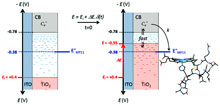Publication
777
J. Phys. Chem. C, 119 (27), 14929-14937, 2015
DOI:10.1021/acs.jpcc.5b02376
|
|
|
|
|
|
 |
Chronoabsorptometry to investigate conduction band mediated electron transfer in mesoporous TiO2 thin films |
|
|
|
Christophe Renault, Véronique Balland, Benoît Limoges, and Cyrille Costentin
Laboratoire d’Electrochimie Moléculaire, UMR 7591 CNRS, Université Paris Diderot, Sorbonne Paris Cité, 15 rue Jean-Antoine de Baïf, F-75205 Paris Cedex 13, France
Chronoabsorptometry response of transparent mesoporous semiconductive metal oxide film loaded with a redox-active dye is established in the framework of fast electron diffusion. It is shown that the effect of uncompensated resistance is to delay the electron accumulation in the semiconductive thin film. Consequently, this effect must be duly taken into account when interfacial charge transfer rates between the adsorbed redox species and the porous semiconductor are extracted from chronoabsorptometry responses. This is illustrated with the quantitative analysis of the chronoabsorptometry responses of a heme-based redox probe strongly adsorbed in highly ordered mesoporous TiO2 thin films (prepared from evaporation-induced self-assembly, EISA). It is shown that the reduction of the redox probe originates from the conduction band and not from the localized traps in the bandgap. These results are in quantitative agreement with differential cyclic voltabsorptometry recently reported by us, thus showing full consistency of both methods. |

